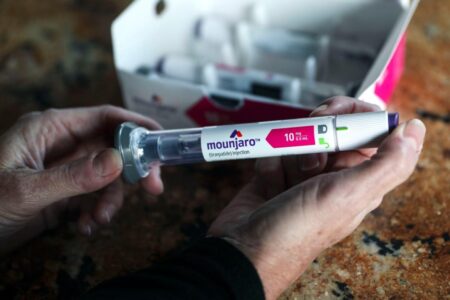-
Eli Lilly stock could soar 140% by 2028 as millions of Americans begin to take their GLP-1 weight loss drugs, according to Goldman Sachs.
-
The firm estimated that if all GLP-1 trials succeed, 68 million Americans could be taking the drugs by 2028.
-
“Total annual revenue has the potential to reach $400 billion in a scenario where all 23 upcoming studies are successful,” Goldman said.
Eli Lilly stock has been on a tear over the past year, but it could still have significant upside ahead, according to new research from Goldman Sachs.
The bank said the rapid rise of GLP-1 diabetes and weight loss drugs like Eli Lilly’s Mounjaro and Zepbound and Novo Nordisk’s Ozempic and Wegovy could lead to as many as 68 million Americans taking the drug by 2028, or about 20% of the country’s population.
That potential success could drive GLP-1 drug revenues to soar to $400 billion, which is well ahead of some Wall Street estimates that suggests GLP-1 drugs will do only $100 billion in revenue by 2030.
“Total annual revenue has the potential to reach $400 billion in a scenario where all 23 upcoming studies are successful, manufacturing is able to meet growing demand and pricing is consistent with our previously published models,” Goldman analysts said.
While a lot has to go right for Goldman’s projection to prove true, the bank highlights that investors are underestimating how far-reaching GLP-1 drugs can be beyond obesity, and compared the drugs to a platform akin to Apple’s iPhone and Amazon’s e-commerce business.
“With the recent success of GLP-1s, we believe Eli Lilly, Novo Nordisk and others have the opportunity to expand into categories far beyond what most investors are currently contemplating,” Goldman said.
The firm said the most important GLP-1 studies investors should watch are the SYNCHRONIZA-CVOT, REDEFINE-3, and the SURMOUNT-MMO from Boehringer Ingelheim, Novo Nordisk, and Eli Lilly, respectively.
These studies are researching the benefit of taking GLP-1 drugs for the treatment of cardiovascular disease regardless of the patient’s weight. If they meet their primary endpoints, the studies could open the floodgates for insurance coverage of GLP-1 drugs and increase demand for GLP-1s by 9 million people, according to Goldman.
The firm said the studies, which are likely to be released in 2026 and 2027, “are likely to support” FDA approval for GLP-1 drugs in the treatment of cardiovascular diseases.
“While we estimate this FDA approval will only increase the approved population by 2 million, we see the potential for these studies to expand corporate insurance coverage by an incremental 40% given other medicines approved to treat this indication are typically covered,” Goldman explained.
The bank added that these studies could spur Medicare and Medicaid to begin covering the costs of the drug for cardiovascular disease.
GLP-1 drugs are also being studied for potential benefits in treating obstructive sleep apnea, chronic kidney disease, liver disease, knee osteoarthritis, and even Alzheimer’s disease.
With new indications for GLP-1 drugs likely to roll in, according to Goldman, more and more people should begin to take the drugs, helping significantly boost revenues and profits for Eli Lilly.
“GLP-1 based medicines will have a profound effect on the health of individuals, the manufacturers of these drugs and the broader healthcare system over the next 10 years, in our view. In many of the scenarios that we envision, annual revenue generated from this class of prescription drug will be the largest ever,” Goldman Sachs said.
That means Eli Lilly stock could still have more upside than is currently priced into the shares.
In Goldman’s most bullish scenario, assuming Eli Lilly captures 50% of the GLP-1 market, ramps up sufficient supply, and achieves profit margins consistent with blockbuster drugs, Eli Lilly stock could more than double to a market valuation of $1.2 trillion.
That lines up with the thinking of billionaire investor Ken Langone, who argued last week that Eli Lilly will become the first trillion-dollar drug company in history.
Despite the bullish projections, Goldman still rates Eli Lilly with a “Neutral” rating and a $600 price target, representing potential upside of 5% from current levels.
Read the original article on Business Insider
